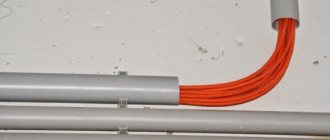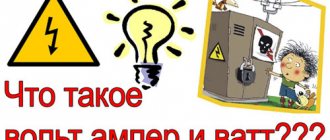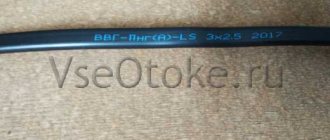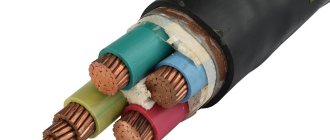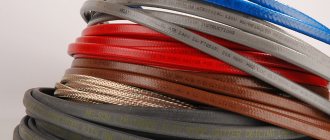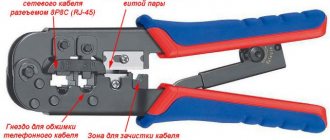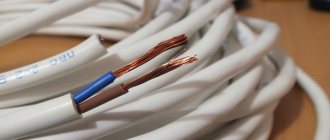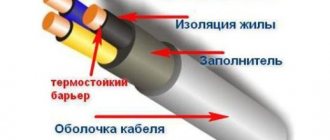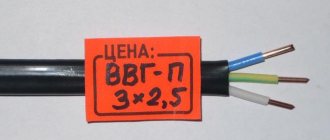AWG - American wire gauge
The abbreviation AWG (American Wire Gauge) literally stands for “American wire gauge”. The word caliber is used here for a reason. Overseas electricians mark wiring in a slightly different way than Russian ones. The calculation does not take into account the cross-section of the current-carrying core in square millimeters, but the number of cycles of drawing and thinning the wire.
For example, an AWG 0 wire with a diameter of 8 mm and a cross-section of 50.24 sq. mm passed through the rollers of the rolling machine 0 times. Essentially, this is a blank for making thinner cores. Conductor AWG 24 with a diameter of 0.51 mm and a cross-section of 0.204 sq. mm was rolled 24 times, so it is 100 times thinner.
Cable gauge AWG
This approach to designating a section creates difficulties for domestic specialists. Indeed, according to this standard, AWG 0 has a larger cross-section than 24.
Origin of the marking
Previously, in the USA, wiring was made using the drawing method. A solid copper rod corresponding to AWG 0 caliber was taken. Then it was threaded into special rolling machines. The wire passed through a series of rollers and decreasing holes. As a result, its diameter was reduced to the required value.
If the workpiece went through 1 thinning cycle, then the output was AWG 1 wire. If 2, then AWG 2. The number of cycles reached several tens. With each passage through the machine, the conductor became thinner in cross-section, but 1 unit larger in caliber.
It is worth noting that AWG 0 is not the thickest wire. In addition to it, there are calibers 00, 000 and 0000. But they are used much less frequently. In this case, the more zeros in the decoding, the thicker the wire.
Important! It is necessary to distinguish between AVVG and AWG cables. These are completely different types of conductor products that have similar designations.
Cable assignment
AWG conductors are used in the same industries as any other similar in structure. Most often these are the following areas of application:
- Construction of communication lines. If there is a screen, the cables can be used to lay the Internet or telephone network.
- Use in audio technology. AWG 22 and 24 transmit sound in some headphone models. This speaker wire is suitable for such purposes due to its high flexibility.
- Most wiring in cars is done using AWG wire. Typically 23 gauge twisted pair is used.
- Connecting LED strips and other low-voltage diode lighting sources. Due to its small thickness and flexibility, it fits conveniently into the grooves for wiring. This property allows you to create a hidden power line.
- Thin wires with a gauge of less than 24 are used in alarm and automation systems. From them lines are drawn for temperature, pressure and humidity sensors of industrial equipment.
Speaker Wire AWG
Cable applications
Cables marked AWG are popularly called twisted pair, since their cores are woven in pairs and form a single wire. There are many industries using such cables.
The main ones:
- Electrical supply of socket networks and diode lamps in domestic and industrial premises. Often the current in such lines does not exceed 24V, and the most common voltage is 12V. This scheme makes it possible to reduce energy costs and is safer than 220V lines.
- Arrangement of wiring in the field of telephony and communications, for example, as lines for connecting to the Internet or local networks.
- In fact, all electrics in vehicles are represented by AWG cables of different gauges. The most commonly used twisted pair is 23 AWG with a longitudinal section, where the conductor can be either single-core or stranded. Power from the battery to the starter and motor is supplied using thicker wires labeled 16 AWG.
TV backlight using AWG wires - These conductors are also used in music centers and televisions. For example, headphones and microphones use 22 or 24 AWG twisted pair, the cross-section in mm of which will be indicated below.
- Cables with the smallest gauge, less than 26 AWG, are used in car alarms, temperature sensors for gas or electric boilers, as well as in automatic fire extinguishing systems. They cannot withstand high voltages, but for networks with low current values they are the best option. For example, 28 AWG wires are widely used in automobile airbag contactors. 30 AWG cable is widely used in Internet connection outlets.
It is strictly forbidden to connect low-current wires to a fixed 220V/380V network. This will inevitably lead to a short circuit.
All of the above areas of wire application are key; in practice, there are significantly more of them. In these industries, non-standard gauge conductors are often found performing data transmission functions.
Low-current networks do not pose a threat to people and animals. The impact of such current is literally not felt by the human body; such networks are the safest and are used in astronautics and other technical industries. Even during open contact with bare wires, a person does not feel an electric shock, so repair work can be carried out without disconnecting the network.
Fiber optic cables manufactured using US technology and marked as 24 AWG (in mm equals 0.644) are actively used. Such networks are stretched both externally and underground. They are designed to transmit data at high speeds.
Cable structure
AWG cables have the same structure as the wires used in Russia. It is based on 2 elements:
- current-carrying conductor;
- layer of protective insulation.
The current conductor is made of electrical copper. Due to its chemical purity, it is possible to achieve a minimum specific resistance of the finished product. The cores can be single-wire (monolithic) or multi-wire (flexible). What to choose depends on the situation. If the installation is complex and there are a lot of wire bends to be made, then flexible cables must be used. If the wiring must remember its shape, then it is monolithic.
Additionally, current-carrying conductors can be tinned with a layer of tin. This increases their anti-corrosion properties and facilitates future soldering.
The insulation is made of foamed polyethylene. In some modifications, additives are added to the composition to increase elasticity or frost resistance. A shielding layer may be located under the insulation. In this case, the conductor becomes resistant to external interference.
Cable design and composition
In accordance with the task being solved, conductors marked as AWG can have different gauges and types of external winding.
This primarily applies to single-core conductors with different base thicknesses and an outer insulating layer of polypropylene foam. The core can be braided and consist of several layers of aluminum or copper strands twisted in a spiral manner. Their thickness index directly affects the degree of current resistance - the greater the number of cores and their thickness index, the weaker the resistance value and loss per meter of conductor will be. This value also affects the degree of heating of the metal under increased loads. Large-caliber conductors are more resistant to heat, which significantly extends the life of common lines.
Multi-wire cables
Stranded AWG wires are woven from many solid wires. Each individual current conductor has individual polypropylene insulation. A separate protective layer is applied on top of it. Sometimes it is supplemented with armor.
A common example of multi-core cables is twisted pair. Due to the twisting of the wires, the wire has increased elasticity, which makes its installation more convenient. And a large number of color combinations of individual conductors is beneficial from a marking point of view. Such a cable is often supplemented with a thin but strong thread. It is necessary to increase tensile strength. Also used for quick and convenient cable cutting.
Twisted pair AWG
Additional Information. There are flexible stranded AWG cables with silicone insulation. This material can withstand temperatures of hundreds of degrees without melting. Therefore, such wiring is used in devices with increased heat generation or where large currents flow through the conductor for a short time.
terms of Use
When carrying out installation work, you must first of all remember the strict prohibition on applying voltage to the wires that exceeds the specific nominal value. This entails overheating of the wires and often ends in a short circuit. Laying in the ground must be carried out using an asbestos sleeve to protect against current. When pulling the wire between the supports, you need to use guide cables, the function of which is to relieve tension from the cables.
Wires with American coding are widely available in domestic stores and are used for various purposes. When working with such products, it is important to be able to find the main parameters of the conductor by its caliber.
Conversion table for AWG wires to mm2
There are difficulties in understanding AWG wire gauges. The larger the caliber, the thinner the core thickness. This discrepancy creates problems during repair and wiring design.
In order not to have to calculate the cable cross-section every time or not to use calculators, experts have created a special table of wires. It shows the relationship between AWG gauge, its cross-section and the maximum permissible current.
| Wire gauge | Section, sq. mm | Continuous permissible current, A (with insulation, at 60°C) |
| 0000 | 107 | 195 |
| 000 | 85 | 165 |
| 00 | 67,4 | 145 |
| 0 | 53,5 | 125 |
| 1 | 42,4 | 110 |
| 2 | 33,6 | 95 |
| 3 | 26,7 | 85 |
| 4 | 21,2 | 70 |
| 5 | 16,8 | – |
| 6 | 13,3 | 55 |
| 7 | 10,5 | – |
| 8 | 8,37 | 40 |
| 9 | 6,63 | – |
| 10 | 5,26 | 30 |
| 11 | 4,17 | – |
| 12 | 3,31 | 25 |
| 13 | 2,62 | – |
| 14 | 2,08 | 20 |
| 15 | 1,65 | – |
| 16 | 1,31 | 15 |
| 17 | 1,04 | – |
| 18 | 0,823 | 10 |
| 19 | 0,653 | – |
| 20 | 0,518 | 5 |
| 21 | 0,41 | – |
| 22 | 0,326 | 4,5 |
| 23 | 0,258 | – |
| 24 | 0,205 | 2,1 |
| 25 | 0,162 | – |
| 26 | 0,129 | 1,3 |
| 27 | 0,102 | – |
| 28 | 0,081 | 0,83 |
| 29 | 0,064 | – |
| 30 | 0,051 | 0,52 |
| 31 | 0,04 | – |
| 32 | 0,032 | 0,32 |
| 33 | 0,025 | – |
| 34 | 0,02 | 0,18 |
| 35 | 0,016 | – |
| 36 | 0,013 | – |
| 37 | 0,01 | – |
| 38 | 0,0079 | – |
| 39 | 0,0063 | – |
| 40 | 0,005 | – |
Formulas for calculation
When dealing with AWG wires and calculating their cross-section, you can use the formulas below.
Convert caliber to diameter (inches inch)
Where,
- n - wire gauge;
- dinch - diameter in inches.
Convert caliber to diameter (in mm)
Where,
- n - caliber;
- dmm — wire diameter, mm.
In some situations it is necessary to calculate the wire cross-section by gauge. For a similar case, a formula (simplified) is also derived:
Here,
- An - wire cross-section, sq. mm;
- n - caliber (note the “-” sign);
And finally, a few general formulas that will be useful in calculations. Wire cross-section through diameter:
Where,
- A - wire cross-section, sq. mm (inches);
- d—diameter, mm (inches).
Convert diameter in inches to millimeters:
Here,
- dmm - wire diameter in mm;
- dinch - diameter in inches.
Calculation formulas
The formula for converting calibers to millimeters is as follows:
The indicator 0.005 inches, when converted, is 0.127 mm. The value n is the caliber nomenclature. The presented formula is valid only for solid cores of cables and wires.
The values “36”, “39” and “92” are present in the formula for a reason. In the late 90s, the AWG indicator, the diameter of which is equal to 0.005 inch, corresponded to gauge 36. In those years, this was the thinnest wire. The thickest cable was caliber AWG 0000. The ratio between the smallest and largest diameter is exactly “92”.
The calibration range, starting from marking AWG 36, consists of 38 consecutive calibers and the ratio between them is a constant value. Between adjacent calibers the ratio is 1.1229. This figure is the 39th root of 92.
For large calibers, the role of “n” is the negative indicator -(m-1).
Electricians' Observations
Over the years, practicing electricians have noticed a number of empirical facts that relate to the diameter and cross-section of AWG wiring. The main ones are:
- If you increase the wire gauge by 4 points, it will be able to withstand 2 times the melting current. This approach allows you to select the cross-section of cores without calculators and formulas.
- If you increase the cross-sectional area of the cable core by 2 times, then its caliber will decrease by 3 points. This value is approximate, but in some cases this accuracy is sufficient.
- Increasing the diameter of the wire by 2 times leads to a decrease in its caliber by 6 positions. This pattern was also discovered experimentally.
Important! If you are repairing an electrical appliance with a heating element, then it will most likely have a wire in heat-resistant silicone insulation. It cannot be replaced with a conductor with a regular, easily melting protective layer.
Rules of thumb
The sixth level of the ratio of the diameters of two adjacent AWG calibers is extremely close to 2 (2.005), which dictates the following rules:
- Doubling the cable diameter leads to a reduction in gauge by 6 notches.
- Doubling the cable cross-section entails a reduction in caliber by 3 units.
- Reducing the gauge by 4 units doubles the melting current of the cable.
Lowering the caliber by 10 units increases the area and mass by approximately 10 times and also reduces the degree of resistance by approximately 10 times.
Performance characteristics
AWG standard wiring has the same technical characteristics and operating conditions as cables familiar to Russian electricians. Therefore, these types of conductor products have common features:
- The cable insulation must not be damaged. This point should be checked when laying or installing wiring. Cracks and holes in the protective insulating layer will lead to moisture entering the cable cavities and the risk of it burning out.
- AWG wire is selected according to the permissible current and operating voltage. If the current value is exceeded, the cable insulation will melt. And if you overdo the voltage, an insulation breakdown will occur.
- Along the walls, cables are laid in separate fire protection. For example, in an installation channel or corrugation. This rule is especially relevant for wooden buildings.
- There should be no open sections of current-carrying conductors. Regardless of voltage. All connections are sealed with insulating tape or heat-shrinkable tubing.
From a design perspective, AWG is no different from other types of installation wire. The only difference is in the markings. The higher the gauge of the wire, the thinner it is. Such a system is the opposite of that adopted in the countries of the post-Soviet space.
AWG wire is universal. It is suitable for installation of lighting systems, auto electrics, sound and signal networks. When using it, the main thing is not to get confused about the diameter of the current-carrying wires. There are special formulas for calculating the required wiring cross-section and converting it into the usual square meters. mm.
